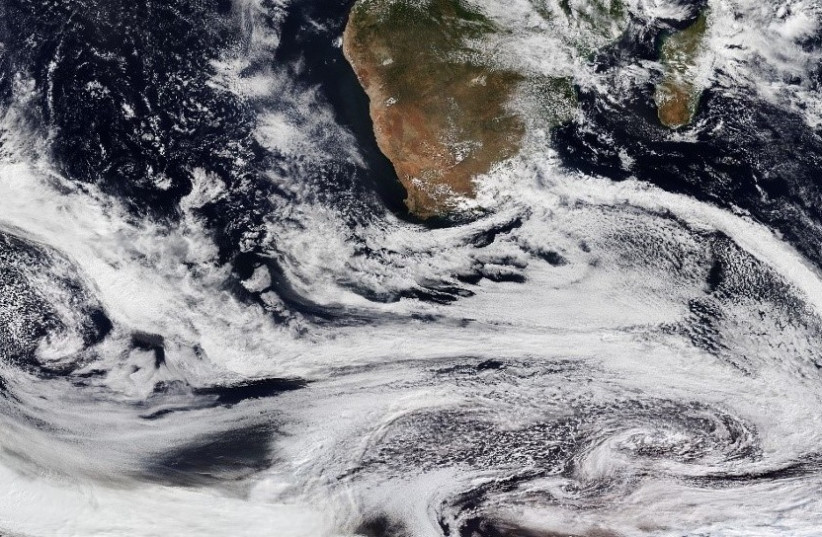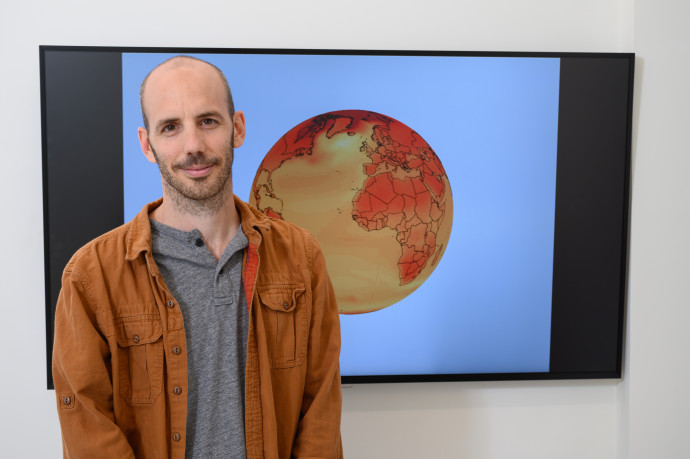A new Weizmann Institute-led study reveals that storms in the Southern Hemisphere have already reached intensity levels projected to be reached only by 2080.
Published: MAY 28, 2022

A team of scientists from the Earth and Planetary Sciences Department at the Weizmann Institute, led by Dr. Rei Chemke, has found a considerable intensification of winter storms in the Southern Hemisphere.
Until now, climate models have projected a human-caused intensification of winter storms only toward the end of this century, but a new study, conducted in collaboration with Dr. Yi Ming of Princeton University and Dr. Janni Yuval of MIT, challenges those projections.
Chemke and his team compared climate model simulations with current storm observations. Through their research, it became clear that storm intensification over recent decades has already reached levels it was projected to reach no earlier than 2080.
“A winter storm is a weather phenomenon that lasts only a few days. Individually, each storm doesn’t carry much climatic weight. However, the long-term effect of winter storms becomes evident when assessing cumulative data collected over long periods of time,” Chemke explained.
“One example of this is the role the storms play in regulating the temperature at the Earth’s poles,” he said. “Winter storms are responsible for the majority of the heat transport away from tropical regions toward the poles. Without their contribution, the average pole temperatures would be about 30°C lower.”

Cumulatively, these storms have a significant impact, affecting the transfer of heat, moisture and momentum within the atmosphere, which consequently affects the various climate zones on Earth.
The collective intensification of these storms yields a real and significant threat to societies in the Southern Hemisphere in the upcoming decades.
“We chose to focus on the Southern Hemisphere because the intensification registered there has been stronger than in the Northern Hemisphere,” Chemke said.
“We didn’t examine the Northern Hemisphere, but it seems that the intensification of storms in this hemisphere is slower compared to that in the Southern Hemisphere,” he said. “If the trend persists, we will be observing more significant winter storm intensification here in the upcoming years and decades.”
“We will be observing more significant winter storm intensification here in the upcoming years and decades.”
Dr. Rei Chemke
The researchers discovered the physical process behind the storm intensification. An analysis of the growth rate of the storms showed that changes in atmospheric jet streams over the past few decades have caused these escalations, and current climate models are unable to reflect these changes accurately.
Chemke, Ming and Yuval’s study has two immediate, significant implications.
First, it shows that not only will climate projections for the coming decades be worse than what previous assessments have predicted, but the study also suggests that human activity might have a greater impact on the Southern Hemisphere than previously thought.
This means that rapid and decisive intervention is required in order to halt the climate damage in this region.
Second, a correction of the bias in climate models is needed for more accurate climate projections.
https://www.jpost.com/environment-and-climate-change/article-70789
Israeli-led Study Shows Earth Is Warming Faster Than Anticipated – Haaretz
‘The forecasts were too optimistic,’ says Weizmann Institute researcher, whose study discovered that storms have already reached the level that the models expected only decades later

Lee Yaron May. 26, 2022
Winter storms in the southern hemisphere have intensified much faster than scientists predicted, and have already reached the strength that climate models expected to be reached only around 2080, a study published on Thursday showed.
The study, led by Dr. Rei Chemke of the Weizmann Institute of Science, was published in the journal “Nature Climate Change.”
“The forecasts were too optimistic,” Chemke told Haaretz. “In reality, the forecast for the future will be worse than we thought and the storms will intensify beyond what we had predicted to date.”
This means climate change’s effects on humanity may be even greater than thought, he added.
The models used in reports by the Intergovernmental Panel on Climate Change predicted that carbon emissions would significantly worsen winter storms only toward the end of the century. The new study compared the forecasts produced by these models with actual data and discovered that storms have already reached the level that the models expected only decades later.
Joining Chemke, who is from Weizmann’s department of earth and planetary sciences, are researchers Dr. Yi Ming of Princeton University and Dr. Janni Yuval of MIT.
The researchers found that winter storms have intensified by 12 percent over the last four decades, a level climate models predicted would be reached only around 2080. Because these storms in turn affect the climate, Chemke said, the researchers also examined their effect on convection, or heat transfer, and humidity. They found that convection has increased by 16 percent over the last four decades – a level the models predicted only around 2070.
The scientists sought to verify that the worsening storms stemmed from outside factors, like human activity or solar radiation, rather than internal factors of existing climate systems. They therefore used models to predict the maximum amount of change possible due to internal factors and concluded that winter storms had exceeded this level two decades ago.
Chemke said the study has two immediate and important implications. First, the climate situation in the coming decades will likely be worse than scientists previously thought, since human activity has apparently had a greater effect on the climate in the southern hemisphere than believed. This means the international community must work faster to moderate climate damage in this region.
Second, the existing models, which governments use to set policy, must be corrected to provide more accurate predications about changes in the intensity of storms in the coming decades.
Long-term effects
Though each winter storm lasts only a few days, when many storms combine over a large area and a sizable period of time, they create flows of atmospheric energy that affect broad climatic regions. For instance, storms are responsible for most of the heat transfer from the tropics to the poles. Without this heat transfer, the average temperature at the poles would be 30 degrees lower.
Consequently, the intensified storms of recent years have significant implications for the climate overall.
The researchers compared current data with the predictions of the 30 major computer networks used in climate research. Each of these networks uses a model comprised of millions of lines of code that calculate the physical, chemical and biological effects of environmental conditions on the earth over the course of hundreds or thousands of years.
The models show the condition of the atmosphere, the oceans, continents and ice shelves. The results are then analyzed by leading researchers worldwide.
Chemke said his study’s findings will help researchers correct these models to produce more accurate predictions.
Prof. Hadas Saaroni, a climatologist from Tel Aviv University’s geophysics department who was not involved in Chemke’s study, deemed it “important research that underscores the fact that even if uncertainty exists, we must not be apathetic.”
“The costs of ignoring the problem and not preparing for it might well be much greater,” she added. “Atmospheric processes aren’t monotonal, and we must take into account that sharp changes are possible in our region, too.”
Prof. Nili Harnik of Tel Aviv University’s geosciences department, an expert in atmospheric circulation who was also not involved in the study, similarly deemed it “important research.”
- Humanity Gets a Failing Grade on the Climate Crisis
- ‘Earth Has No Climate Problem. We’re the Ones Who Won’t Survive Within Decades’
- Israel Can Become a Key Player in Battle Against Climate Change, Kerry Tells Haaretz
“It shows that the weather is becoming stormier in the southern hemisphere significantly even now, not decades in the future,” she said. “In general, when trends are hard to predict, there is disagreement among different models. Here, there’s agreement on the general trend of storms intensifying, but the models underestimate the strength of the response.
“The model’s tendency to underestimate how winds and storms respond to external constraints is familiar in other contexts, but this is the first time someone has shown that how the intensity of storms responds to the rise in concentrations of warming gases is too weak in these models,” she continued. “These are worrying results that come on top of many others that show the need to reduce emissions of warming gases as fast as possible.
